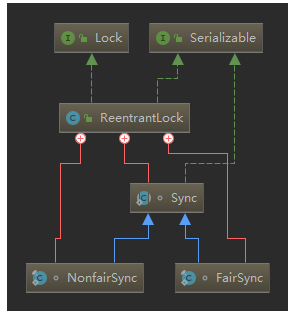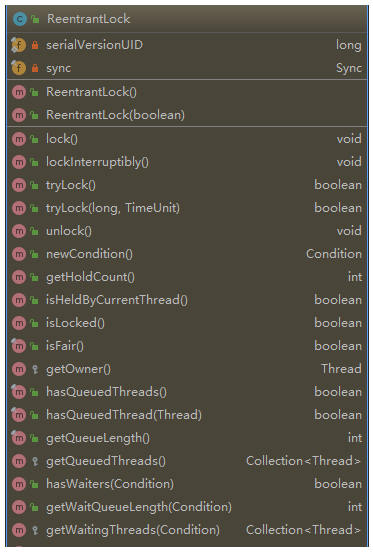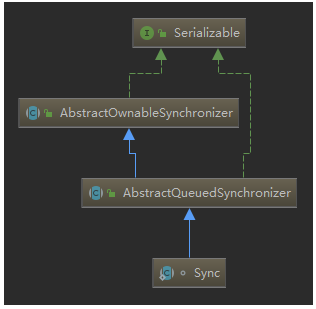前言:JUC包,ReentrantLock源码学习
简介
ReentrantLock实现Lock接口,内部类继承了AQS,是一种可重入的独占锁,支持公平锁和非公平锁两种方式。
常用方法
lock():获取锁,获取不到会等待
unlock():释放锁
ReentrantLock(boolean):构造方法,布尔参数决定公平或不公平,默认false
类图


简单应用
1
2
3
4
5
6
7
8
9
10
11
12
13
14
15
16
17
18
19
20
21
22
23
24
25
26
27
28
29
30
31
32
33
34
35
|
public class MyThread implements Runnable{
ReentrantLock lock = new ReentrantLock();
@Override
public void run() {
lock.lock();
System.out.println(Thread.currentThread().getName()+"获得锁");
try {
Thread.sleep(10);
} catch (InterruptedException e) {
e.printStackTrace();
}
System.out.println(Thread.currentThread().getName()+"释放锁");
lock.unlock();
}
}
public class ReentrantLockTest {
public static void main(String[] args) {
MyThread myThead = new MyThread();
for(int i=0;i<100;i++){
new Thread(myThead).start();
}
}
}
|
源码学习
Sync

1
2
3
4
5
6
7
8
9
10
11
12
13
14
15
16
17
18
19
20
21
22
23
24
25
26
27
28
29
30
31
32
33
34
35
36
37
38
39
40
41
42
43
44
45
46
47
48
49
50
51
52
53
54
55
56
57
58
59
60
61
62
63
64
65
66
67
68
69
70
71
72
| abstract static class Sync extends AbstractQueuedSynchronizer {
private static final long serialVersionUID = -5179523762034025860L;
abstract void lock();
final boolean nonfairTryAcquire(int acquires) {
final Thread current = Thread.currentThread();
int c = getState();
if (c == 0) {
if (compareAndSetState(0, acquires)) {
setExclusiveOwnerThread(current);
return true;
}
}
else if (current == getExclusiveOwnerThread()) {
int nextc = c + acquires;
if (nextc < 0)
throw new Error("Maximum lock count exceeded");
setState(nextc);
return true;
}
return false;
}
protected final boolean tryRelease(int releases) {
int c = getState() - releases;
if (Thread.currentThread() != getExclusiveOwnerThread())
throw new IllegalMonitorStateException();
boolean free = false;
if (c == 0) {
free = true;
setExclusiveOwnerThread(null);
}
setState(c);
return free;
}
protected final boolean isHeldExclusively() {
return getExclusiveOwnerThread() == Thread.currentThread();
}
final ConditionObject newCondition() {
return new ConditionObject();
}
final Thread getOwner() {
return getState() == 0 ? null : getExclusiveOwnerThread();
}
final int getHoldCount() {
return isHeldExclusively() ? getState() : 0;
}
final boolean isLocked() {
return getState() != 0;
}
private void readObject(java.io.ObjectInputStream s)
throws java.io.IOException, ClassNotFoundException {
s.defaultReadObject();
setState(0);
}
}
|
NonfairSync
1
2
3
4
5
6
7
8
9
10
11
12
13
14
15
16
| static final class NonfairSync extends Sync {
private static final long serialVersionUID = 7316153563782823691L;
final void lock() {
if (compareAndSetState(0, 1))
setExclusiveOwnerThread(Thread.currentThread());
else
acquire(1);
}
protected final boolean tryAcquire(int acquires) {
return nonfairTryAcquire(acquires);
}
}
|
FairSync
1
2
3
4
5
6
7
8
9
10
11
12
13
14
15
16
17
18
19
20
21
22
23
24
25
26
27
28
29
30
| static final class FairSync extends Sync {
private static final long serialVersionUID = -3000897897090466540L;
final void lock() {
acquire(1);
}
protected final boolean tryAcquire(int acquires) {
final Thread current = Thread.currentThread();
int c = getState();
if (c == 0) {
if (!hasQueuedPredecessors() &&
compareAndSetState(0, acquires)) {
setExclusiveOwnerThread(current);
return true;
}
}
else if (current == getExclusiveOwnerThread()) {
int nextc = c + acquires;
if (nextc < 0)
throw new Error("Maximum lock count exceeded");
setState(nextc);
return true;
}
return false;
}
}
|
构造方法
默认不公平模式
1
2
3
4
5
6
7
| public ReentrantLock() {
sync = new NonfairSync();
}
public ReentrantLock(boolean fair) {
sync = fair ? new FairSync() : new NonfairSync();
}
|
getHoldCount
返回加锁次数
1
2
3
| public int getHoldCount() {
return sync.getHoldCount();
}
|
getOwner
返回获得锁的线程
1
2
3
| protected Thread getOwner() {
return sync.getOwner();
}
|
getQueuedThreads
返回CLH队列的线程集合
1
2
3
| protected Collection<Thread> getQueuedThreads() {
return sync.getQueuedThreads();
}
|
getQueueLength
返回CLH队列长度
1
2
3
| public final int getQueueLength() {
return sync.getQueueLength();
}
|
getWaitingThreads
返回Condition队列的线程集合
1
2
3
4
5
6
7
| protected Collection<Thread> getWaitingThreads(Condition condition) {
if (condition == null)
throw new NullPointerException();
if (!(condition instanceof AbstractQueuedSynchronizer.ConditionObject))
throw new IllegalArgumentException("not owner");
return sync.getWaitingThreads((AbstractQueuedSynchronizer.ConditionObject)condition);
}
|
getWaitQueueLength
返回Condition队列长度
1
2
3
4
5
6
7
| public int getWaitQueueLength(Condition condition) {
if (condition == null)
throw new NullPointerException();
if (!(condition instanceof AbstractQueuedSynchronizer.ConditionObject))
throw new IllegalArgumentException("not owner");
return sync.getWaitQueueLength((AbstractQueuedSynchronizer.ConditionObject)condition);
}
|
hasQueuedThread
判断线程是否在CLH队列中
1
2
3
| public final boolean hasQueuedThread(Thread thread) {
return sync.isQueued(thread);
}
|
hasQueuedThreads
判断CLH队列是否有元素(线程)
1
2
3
| public final boolean hasQueuedThreads() {
return sync.hasQueuedThreads();
}
|
hasWaiters
判断Condition队列是否有元素(线程)
1
2
3
4
5
6
7
| public boolean hasWaiters(Condition condition) {
if (condition == null)
throw new NullPointerException();
if (!(condition instanceof AbstractQueuedSynchronizer.ConditionObject))
throw new IllegalArgumentException("not owner");
return sync.hasWaiters((AbstractQueuedSynchronizer.ConditionObject)condition);
}
|
isFair
判断是否公平锁
1
2
3
| public final boolean isFair() {
return sync instanceof FairSync;
}
|
isHeldByCurrentThread
判断当前线程是否获取到锁
1
2
3
| public boolean isHeldByCurrentThread() {
return sync.isHeldExclusively();
}
|
isLocked
判断是否锁定
1
2
3
| public boolean isLocked() {
return sync.isLocked();
}
|
lock
常用方法,获取锁
1
2
3
| public void lock() {
sync.lock();
}
|
lockInterruptibly
同lock,可响应异常
1
2
3
| public void lockInterruptibly() throws InterruptedException {
sync.acquireInterruptibly(1);
}
|
newCondition
创建Condition对象
1
2
3
| public Condition newCondition() {
return sync.newCondition();
}
|
toString
转化为String格式
1
2
3
4
5
6
| public String toString() {
Thread o = sync.getOwner();
return super.toString() + ((o == null) ?
"[Unlocked]" :
"[Locked by thread " + o.getName() + "]");
}
|
tryLock
调用Sync的nonfairTryAcquire获取锁
1
2
3
| public boolean tryLock() {
return sync.nonfairTryAcquire(1);
}
|
限时的tryLock
1
2
3
4
| public boolean tryLock(long timeout, TimeUnit unit)
throws InterruptedException {
return sync.tryAcquireNanos(1, unit.toNanos(timeout));
}
|
unlock
释放锁
1
2
3
| public void unlock() {
sync.release(1);
}
|


